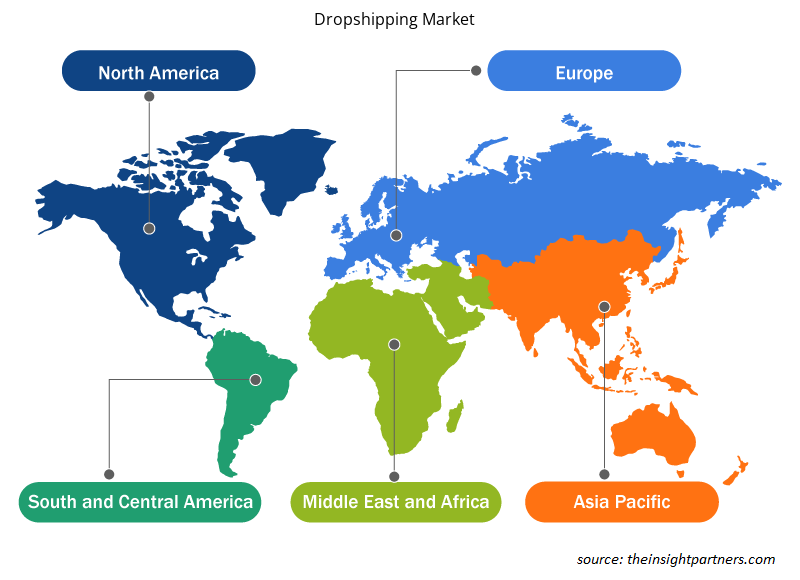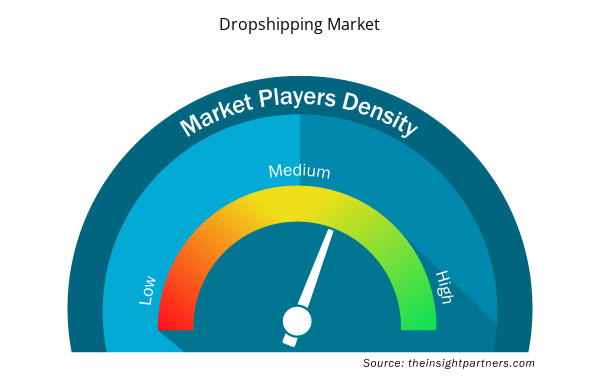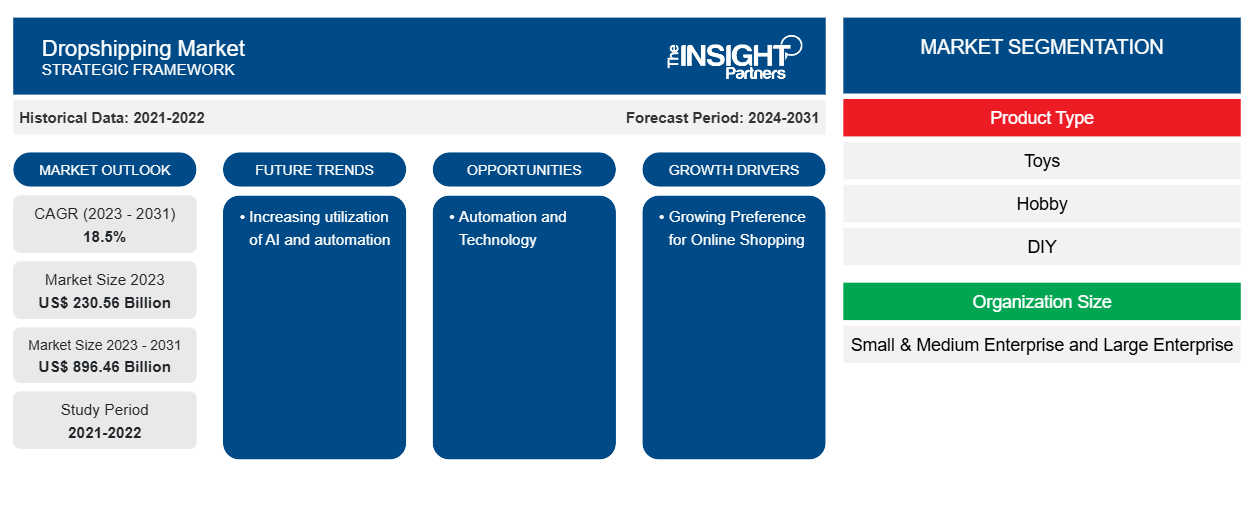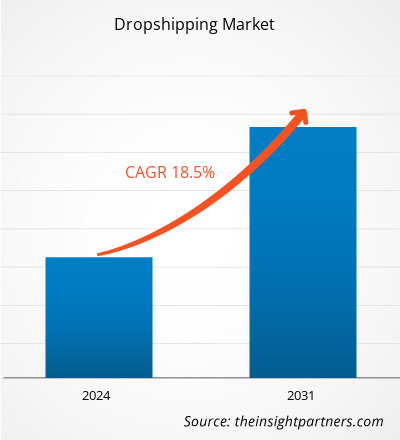Si prevede che le dimensioni del mercato globale del dropshipping cresceranno da 230,56 miliardi di dollari nel 2023 a 896,46 miliardi di dollari entro il 2031; si prevede che si espanderà a un CAGR del 18,5% dal 2023 al 2031. È probabile che l'utilizzo crescente dell'intelligenza artificiale e dell'automazione rimanga una tendenza chiave del mercato del dropshipping.
Analisi del mercato del dropshipping
Il fiorente settore dell'e-commerce ha visto un'enorme espansione negli ultimi anni, dando impulso al business del dropshipping. L'ascesa del settore dell'e-commerce ha reso più semplice per le aziende stabilire vetrine online e accedere a una base di clienti mondiale, dando impulso al mercato del dropshipping.
Panoramica del mercato del dropshipping
Il dropshipping è un approccio al dettaglio in cui un'attività online non tiene i suoi articoli in inventario. Invece, quando un consumatore effettua un ordine, l'attività lo invia insieme al pagamento a un fornitore di dropshipping. Il fornitore invia quindi la merce al consumatore . Molti titolari di attività scelgono il dropshipping perché consente ai fornitori di gestire l'evasione degli ordini. Ciò implica che i rivenditori non devono investire in spazio di stoccaggio o rischiare di rimanere intrappolati con prodotti invenduti. Di conseguenza, le aziende possono dedicare più risorse ad altre operazioni di vendita al dettaglio, incluso il marketing.
Personalizza questo report in base alle tue esigenze
Riceverai la personalizzazione gratuita di qualsiasi report, comprese parti di questo report, o analisi a livello nazionale, pacchetto dati Excel, oltre a usufruire di grandi offerte e sconti per start-up e università
- Scopri le principali tendenze di mercato in questo rapporto.Questo campione GRATUITO includerà analisi di dati che spaziano dalle tendenze di mercato alle stime e alle previsioni.
Driver e opportunità del mercato del dropshipping
Crescente preferenza per lo shopping online per favorire il mercato
L'e-commerce sta trasformando il panorama della vendita al dettaglio. Le abitudini di acquisto delle persone stanno cambiando rapidamente e acquistare qualsiasi cosa online sta diventando il nuovo standard. Questa espansione è guidata da una serie di cause, tra cui lo sviluppo del commercio mobile, l'ascesa dei social network e la crescente popolarità dei servizi in abbonamento. I paesi dell'Asia-Pacifico e del Sud America stanno ora sperimentando lo sviluppo più rapido nel settore dell'e-commerce . Ciò è attribuibile sia al rapido adattamento delle nuove tecnologie sia alla struttura demografica di queste nazioni, che ha più giovani che anziani. Queste giovani generazioni sono più esperte di tecnologia e preferiscono fare acquisti online piuttosto che offline.
Automazione e tecnologia
Il dropshipping è una strategia aziendale in cui il venditore non detiene scorte in magazzino, ma invia gli ordini dei clienti e i dati di spedizione al produttore, a un altro commerciante o a un grossista, che distribuisce i prodotti direttamente al cliente. I drop shipper traggono grandi vantaggi dall'automazione poiché migliora la produttività e semplifica le operazioni. I drop shipper possono risparmiare tempo e ridurre al minimo il carico automatizzando molte aree della loro attività, con conseguente maggiore efficienza e redditività. Il software di automazione del dropshipping aiuta i drop shipper ad automatizzare le attività quotidiane, tra cui l'inoltro degli ordini ai produttori, la gestione dell'inventario e le procedure di spedizione. is a business strategy in which the seller does not hold inventory in stock but instead sends customer orders and shipment data to the manufacturer, another merchant, or a wholesaler, who distributes the products straight to the client. Drop shippers benefit greatly from automation since it improves productivity and streamlines operations. Drop shippers may save time and minimize burden by automating many areas of their business, resulting in a more efficient and profitable operation. Dropshipping automation software helps dropshippers automate daily duties including order routing to manufacturers, inventory management, and shipment procedures.
Analisi della segmentazione del rapporto di mercato del dropshipping Market Report Segmentation Analysis
Segmenti chiave che hanno contribuito alla derivazione dell'analisi di mercato del dropshipping: tipo di prodotto e dimensioni dell'organizzazione.
- In base al tipo di prodotto, il mercato è suddiviso in giocattoli intelligenti, hobby e fai da te, mobili ed elettrodomestici, cibo e cura della persona, elettronica e media, moda e altri. Il segmento dell'elettronica e dei media ha detenuto una quota di mercato maggiore nel 2023.
- In base alle dimensioni dell'organizzazione, il mercato è diviso in piccole e medie imprese e grandi imprese. Il segmento delle grandi imprese ha detenuto una quota di mercato maggiore nel 2023.
Analisi della quota di mercato del dropshipping per area geografica Market Share Analysis by Geography
L'ambito geografico del rapporto sul mercato del dropshipping è principalmente suddiviso in cinque regioni: Nord America, Asia Pacifico, Europa, Medio Oriente e Africa e Sud America/Sud e Centro America. Il Nord America ha dominato il mercato del dropshipping nel 2023. L'aumento del reddito disponibile dei consumatori è uno dei fattori che guidano la crescita del mercato del dropshipping in Nord America. Il dropshipping offre vantaggi come minori costi generali e un ampio portafoglio di prodotti, che attraggono i rivenditori e contribuiscono alla crescita del mercato.
Approfondimenti regionali sul mercato del dropshipping
Le tendenze regionali e i fattori che influenzano il mercato del dropshipping durante il periodo di previsione sono stati ampiamente spiegati dagli analisti di Insight Partners. Questa sezione discute anche i segmenti e la geografia del mercato del dropshipping in Nord America, Europa, Asia Pacifico, Medio Oriente e Africa e Sud e Centro America.

- Ottieni i dati specifici regionali per il mercato del dropshipping
Ambito del rapporto sul mercato del dropshipping
| Attributo del report | Dettagli |
|---|---|
| Dimensioni del mercato nel 2023 | 230,56 miliardi di dollari USA |
| Dimensioni del mercato entro il 2031 | 896,46 miliardi di dollari USA |
| CAGR globale (2023-2031) | 18,5% |
| Dati storici | 2021-2022 |
| Periodo di previsione | 2024-2031 |
| Segmenti coperti | Per tipo di prodotto
|
| Regioni e Paesi coperti | America del Nord
|
| Leader di mercato e profili aziendali chiave |
|
Densità degli attori del mercato: comprendere il suo impatto sulle dinamiche aziendali
Il mercato del Dropshipping sta crescendo rapidamente, spinto dalla crescente domanda degli utenti finali dovuta a fattori quali l'evoluzione delle preferenze dei consumatori, i progressi tecnologici e una maggiore consapevolezza dei vantaggi del prodotto. Con l'aumento della domanda, le aziende stanno ampliando le loro offerte, innovando per soddisfare le esigenze dei consumatori e capitalizzando sulle tendenze emergenti, il che alimenta ulteriormente la crescita del mercato.
La densità degli operatori di mercato si riferisce alla distribuzione di aziende o società che operano in un particolare mercato o settore. Indica quanti concorrenti (operatori di mercato) sono presenti in un dato spazio di mercato in relazione alle sue dimensioni o al valore di mercato totale.
Le principali aziende che operano nel mercato del Dropshipping sono:
- AliDropship
- Società per azioni Doba Inc.
- Zona di Dropshipping
- Fonte di inventario
- Megagoods, Inc.
- Modalyst, Inc.
Disclaimer : le aziende elencate sopra non sono classificate secondo un ordine particolare.

- Ottieni una panoramica dei principali attori del mercato del dropshipping
Notizie e sviluppi recenti del mercato del dropshipping
Il mercato del dropshipping viene valutato raccogliendo dati qualitativi e quantitativi dopo la ricerca primaria e secondaria, che include importanti pubblicazioni aziendali, dati associativi e database. Di seguito è riportato un elenco degli sviluppi nel mercato:
- A marzo 2023, ShipStation ha lanciato ShipStation Dropship Manager, una nuova soluzione progettata specificamente per i gestori di dropship. Questo prodotto mira ad automatizzare e semplificare i processi di evasione degli ordini, riducendo gli errori causati dalla gestione manuale dei fornitori. Le funzionalità principali di ShipStation Dropship Manager includono l'instradamento degli ordini, gli aggiornamenti in tempo reale sullo stato degli ordini tra gestori di dropship e fornitori, il monitoraggio del marchio e la possibilità di utilizzare un dominio e-mail personalizzato per un maggiore coinvolgimento dei clienti. Inoltre, i gestori di dropship possono invitare i propri fornitori a unirsi alla piattaforma, facilitando un rapido onboarding e l'ingresso nel mercato.
(Fonte: ShipStation, Comunicato stampa, 2023)
Copertura e risultati del rapporto sul mercato del dropshipping
Il rapporto "Dimensioni e previsioni del mercato del dropshipping (2021-2031)" fornisce un'analisi dettagliata del mercato che copre le seguenti aree:
- Dimensioni del mercato e previsioni a livello globale, regionale e nazionale per tutti i segmenti di mercato chiave coperti dall'ambito
- Dinamiche di mercato come fattori trainanti, vincoli e opportunità chiave
- Principali tendenze future
- Analisi dettagliata delle cinque forze PEST/Porter e SWOT
- Analisi di mercato globale e regionale che copre le principali tendenze di mercato, i principali attori, le normative e gli sviluppi recenti del mercato
- Analisi del panorama industriale e della concorrenza che copre la concentrazione del mercato, l'analisi della mappa di calore, i principali attori e gli sviluppi recenti
- Profili aziendali dettagliati
- Analisi storica (2 anni), anno base, previsione (7 anni) con CAGR
- Analisi PEST e SWOT
- Valore/volume delle dimensioni del mercato - Globale, regionale, nazionale
- Industria e panorama competitivo
- Set di dati Excel



Report Coverage
Revenue forecast, Company Analysis, Industry landscape, Growth factors, and Trends

Segment Covered
This text is related
to segments covered.

Regional Scope
North America, Europe, Asia Pacific, Middle East & Africa, South & Central America

Country Scope
This text is related
to country scope.
Domande frequenti
The growing e-commerce market has experienced significant growth in recent years, which in turn is driving the dropshipping market.
The key players holding the majority of shares in global dropshipping are AliDropship, Doba Inc., Dropship Zone, Inventory Source, and Megagoods, Inc.
The global dropshipping market is expected to reach US$ 896.46 billion by 2031.
The dropshipping market size is expected to grow from US$ 230.56 billion in 2023 to US$ 896.46 billion by 2031; it is anticipated to expand at a CAGR of 18.5% from 2024 to 2031.
The increasing utilization of AI and automation is likely to remain a key dropshipping market trends.
Trends and growth analysis reports related to Technology, Media and Telecommunications : READ MORE..
The Insight Partners performs research in 4 major stages: Data Collection & Secondary Research, Primary Research, Data Analysis and Data Triangulation & Final Review.
- Data Collection and Secondary Research:
As a market research and consulting firm operating from a decade, we have published and advised several client across the globe. First step for any study will start with an assessment of currently available data and insights from existing reports. Further, historical and current market information is collected from Investor Presentations, Annual Reports, SEC Filings, etc., and other information related to company’s performance and market positioning are gathered from Paid Databases (Factiva, Hoovers, and Reuters) and various other publications available in public domain.
Several associations trade associates, technical forums, institutes, societies and organization are accessed to gain technical as well as market related insights through their publications such as research papers, blogs and press releases related to the studies are referred to get cues about the market. Further, white papers, journals, magazines, and other news articles published in last 3 years are scrutinized and analyzed to understand the current market trends.
- Primary Research:
The primarily interview analysis comprise of data obtained from industry participants interview and answers to survey questions gathered by in-house primary team.
For primary research, interviews are conducted with industry experts/CEOs/Marketing Managers/VPs/Subject Matter Experts from both demand and supply side to get a 360-degree view of the market. The primary team conducts several interviews based on the complexity of the markets to understand the various market trends and dynamics which makes research more credible and precise.
A typical research interview fulfils the following functions:
- Provides first-hand information on the market size, market trends, growth trends, competitive landscape, and outlook
- Validates and strengthens in-house secondary research findings
- Develops the analysis team’s expertise and market understanding
Primary research involves email interactions and telephone interviews for each market, category, segment, and sub-segment across geographies. The participants who typically take part in such a process include, but are not limited to:
- Industry participants: VPs, business development managers, market intelligence managers and national sales managers
- Outside experts: Valuation experts, research analysts and key opinion leaders specializing in the electronics and semiconductor industry.
Below is the breakup of our primary respondents by company, designation, and region:

Once we receive the confirmation from primary research sources or primary respondents, we finalize the base year market estimation and forecast the data as per the macroeconomic and microeconomic factors assessed during data collection.
- Data Analysis:
Once data is validated through both secondary as well as primary respondents, we finalize the market estimations by hypothesis formulation and factor analysis at regional and country level.
- Macro-Economic Factor Analysis:
We analyse macroeconomic indicators such the gross domestic product (GDP), increase in the demand for goods and services across industries, technological advancement, regional economic growth, governmental policies, the influence of COVID-19, PEST analysis, and other aspects. This analysis aids in setting benchmarks for various nations/regions and approximating market splits. Additionally, the general trend of the aforementioned components aid in determining the market's development possibilities.
- Country Level Data:
Various factors that are especially aligned to the country are taken into account to determine the market size for a certain area and country, including the presence of vendors, such as headquarters and offices, the country's GDP, demand patterns, and industry growth. To comprehend the market dynamics for the nation, a number of growth variables, inhibitors, application areas, and current market trends are researched. The aforementioned elements aid in determining the country's overall market's growth potential.
- Company Profile:
The “Table of Contents” is formulated by listing and analyzing more than 25 - 30 companies operating in the market ecosystem across geographies. However, we profile only 10 companies as a standard practice in our syndicate reports. These 10 companies comprise leading, emerging, and regional players. Nonetheless, our analysis is not restricted to the 10 listed companies, we also analyze other companies present in the market to develop a holistic view and understand the prevailing trends. The “Company Profiles” section in the report covers key facts, business description, products & services, financial information, SWOT analysis, and key developments. The financial information presented is extracted from the annual reports and official documents of the publicly listed companies. Upon collecting the information for the sections of respective companies, we verify them via various primary sources and then compile the data in respective company profiles. The company level information helps us in deriving the base number as well as in forecasting the market size.
- Developing Base Number:
Aggregation of sales statistics (2020-2022) and macro-economic factor, and other secondary and primary research insights are utilized to arrive at base number and related market shares for 2022. The data gaps are identified in this step and relevant market data is analyzed, collected from paid primary interviews or databases. On finalizing the base year market size, forecasts are developed on the basis of macro-economic, industry and market growth factors and company level analysis.
- Data Triangulation and Final Review:
The market findings and base year market size calculations are validated from supply as well as demand side. Demand side validations are based on macro-economic factor analysis and benchmarks for respective regions and countries. In case of supply side validations, revenues of major companies are estimated (in case not available) based on industry benchmark, approximate number of employees, product portfolio, and primary interviews revenues are gathered. Further revenue from target product/service segment is assessed to avoid overshooting of market statistics. In case of heavy deviations between supply and demand side values, all thes steps are repeated to achieve synchronization.
We follow an iterative model, wherein we share our research findings with Subject Matter Experts (SME’s) and Key Opinion Leaders (KOLs) until consensus view of the market is not formulated – this model negates any drastic deviation in the opinions of experts. Only validated and universally acceptable research findings are quoted in our reports.
We have important check points that we use to validate our research findings – which we call – data triangulation, where we validate the information, we generate from secondary sources with primary interviews and then we re-validate with our internal data bases and Subject matter experts. This comprehensive model enables us to deliver high quality, reliable data in shortest possible time.


 Ottieni un campione gratuito per questo repot
Ottieni un campione gratuito per questo repot